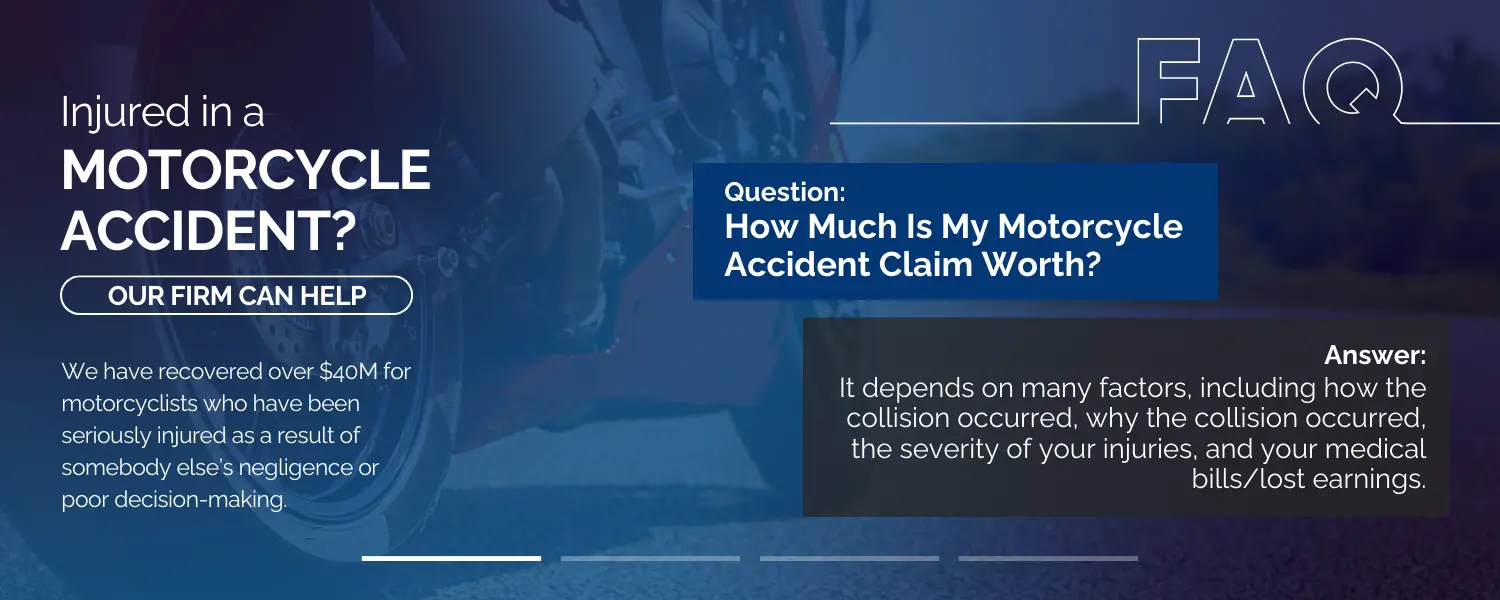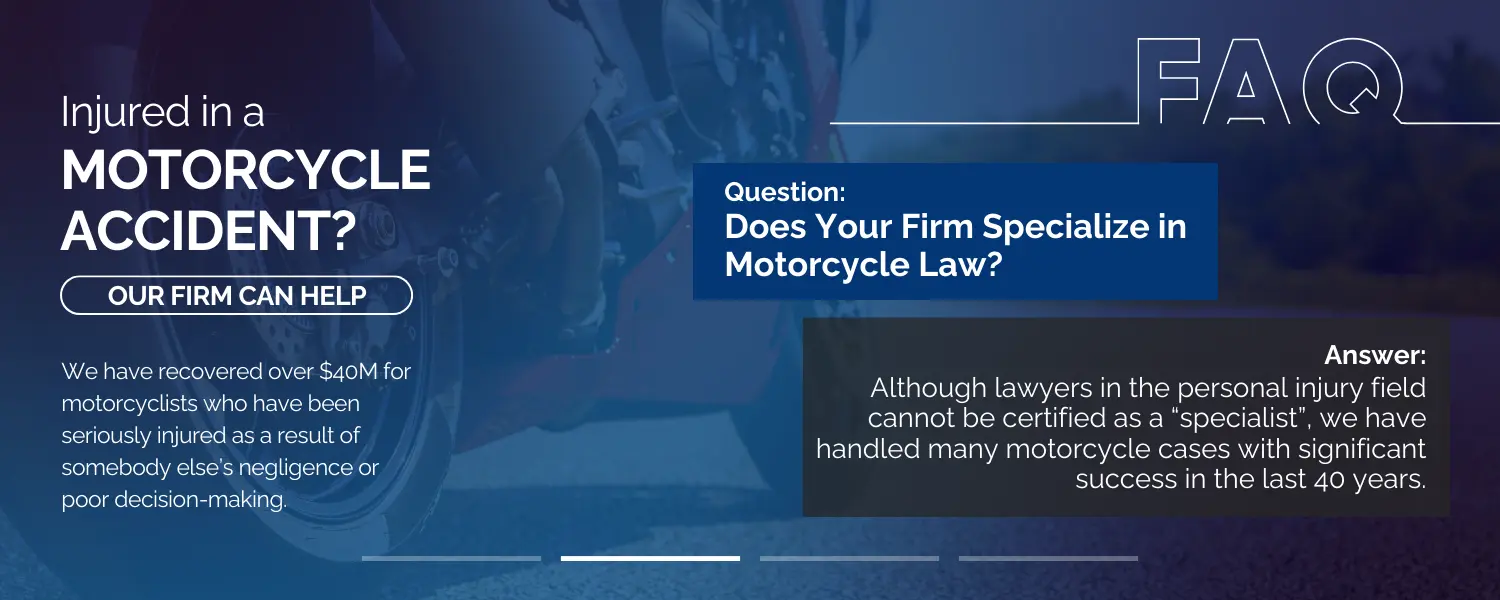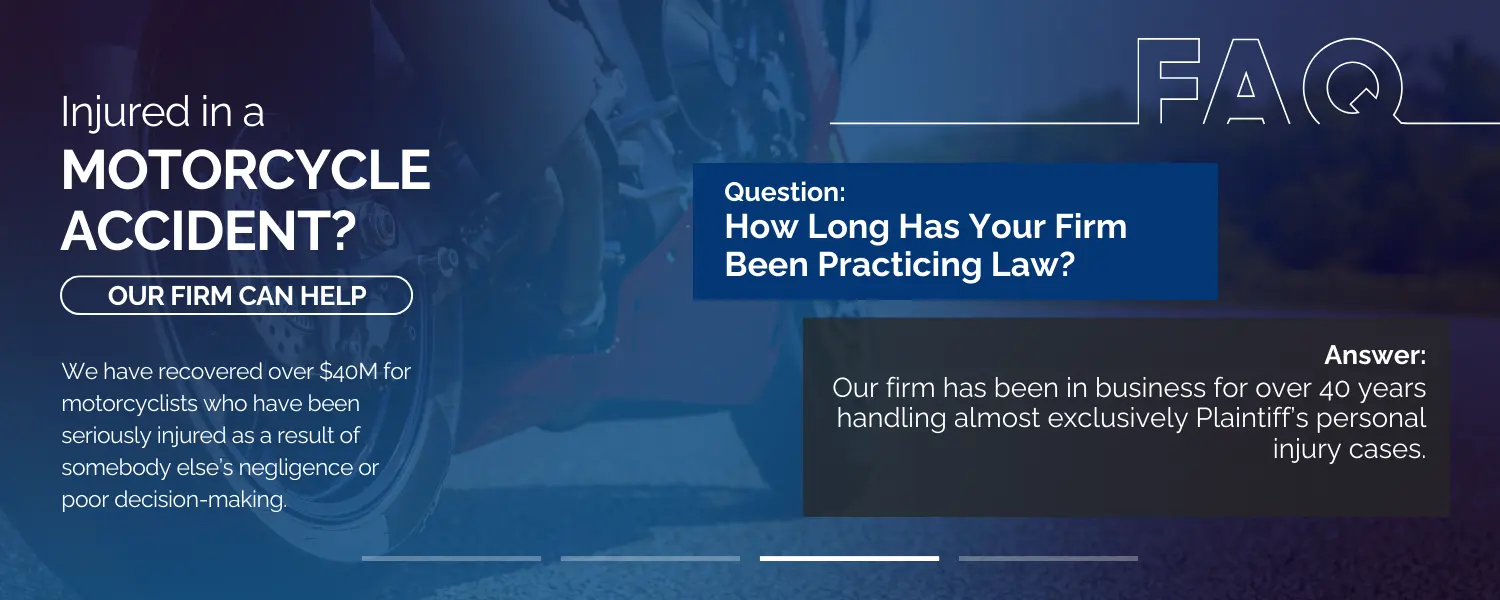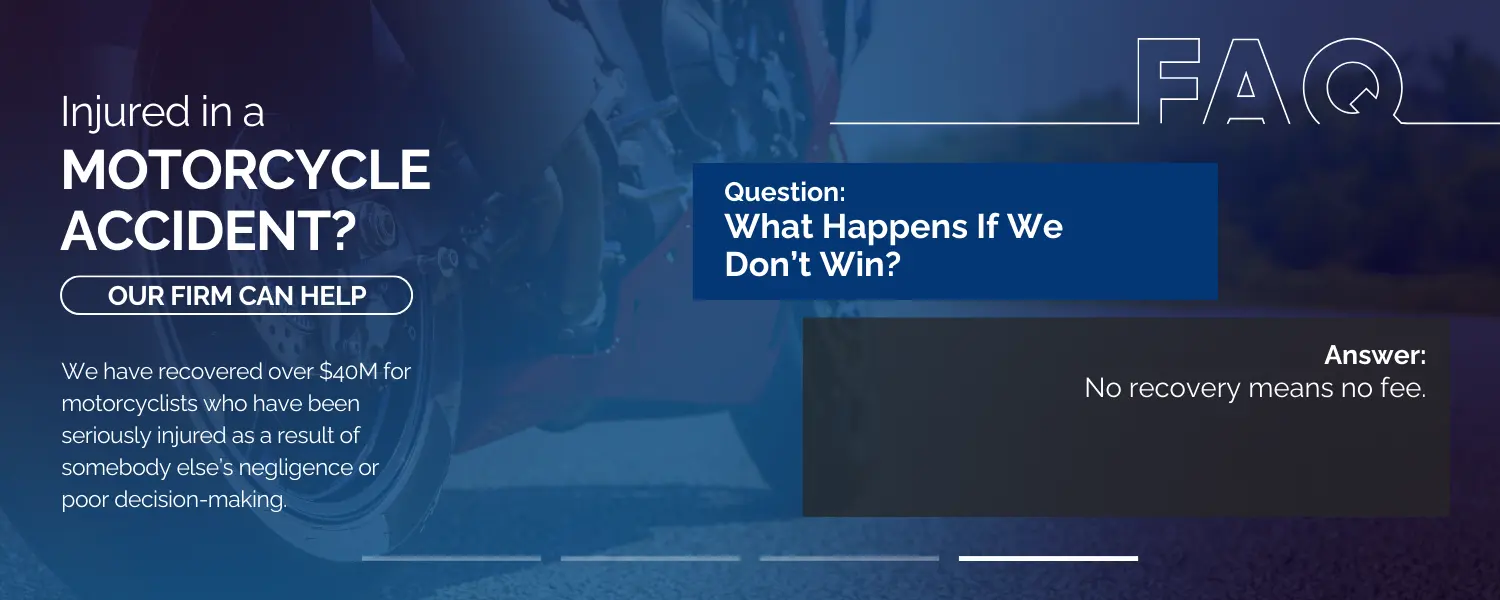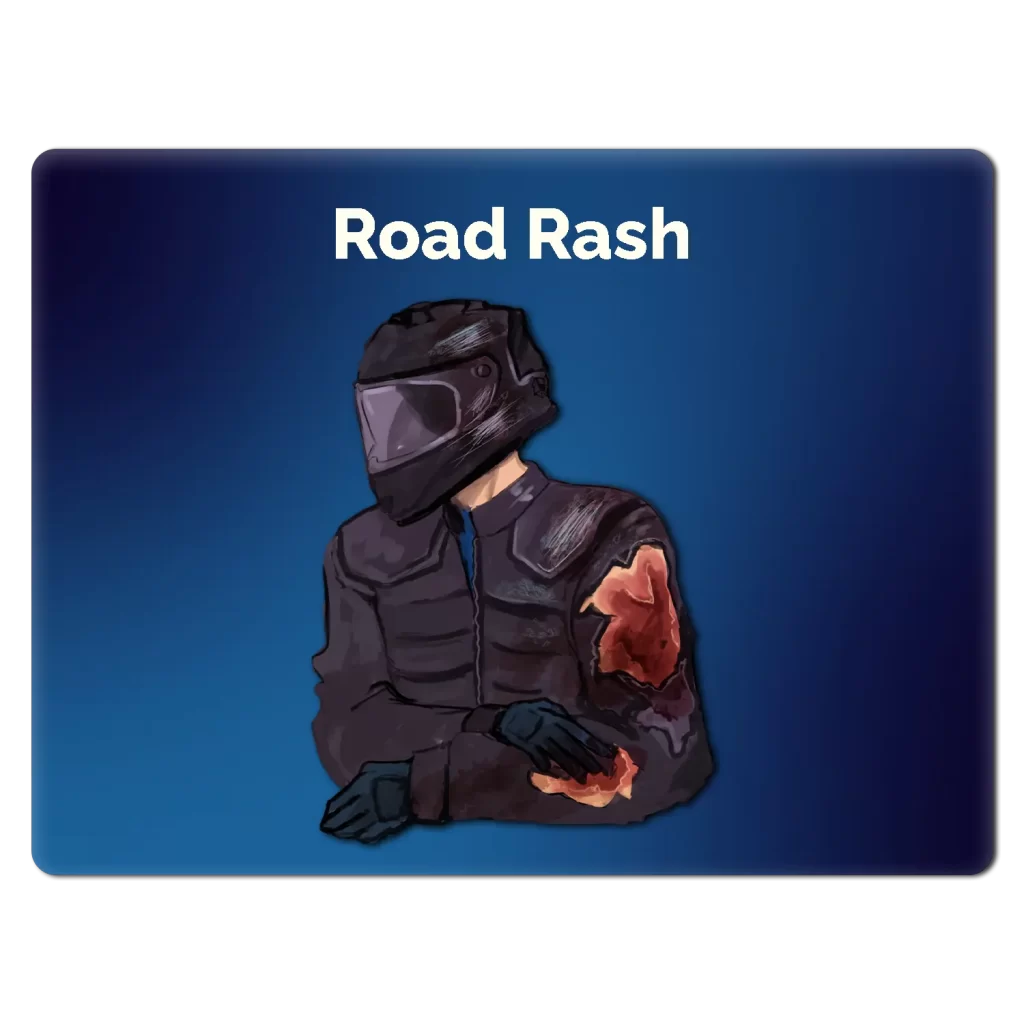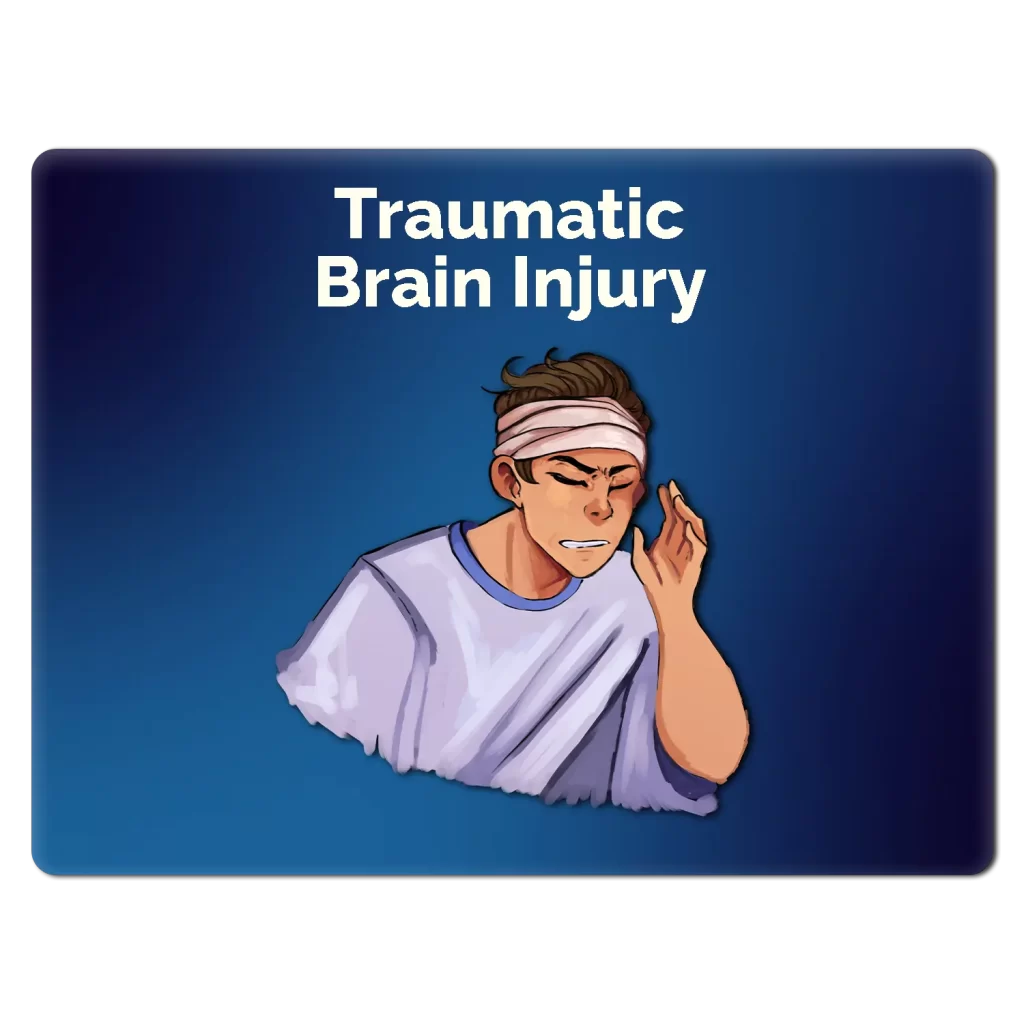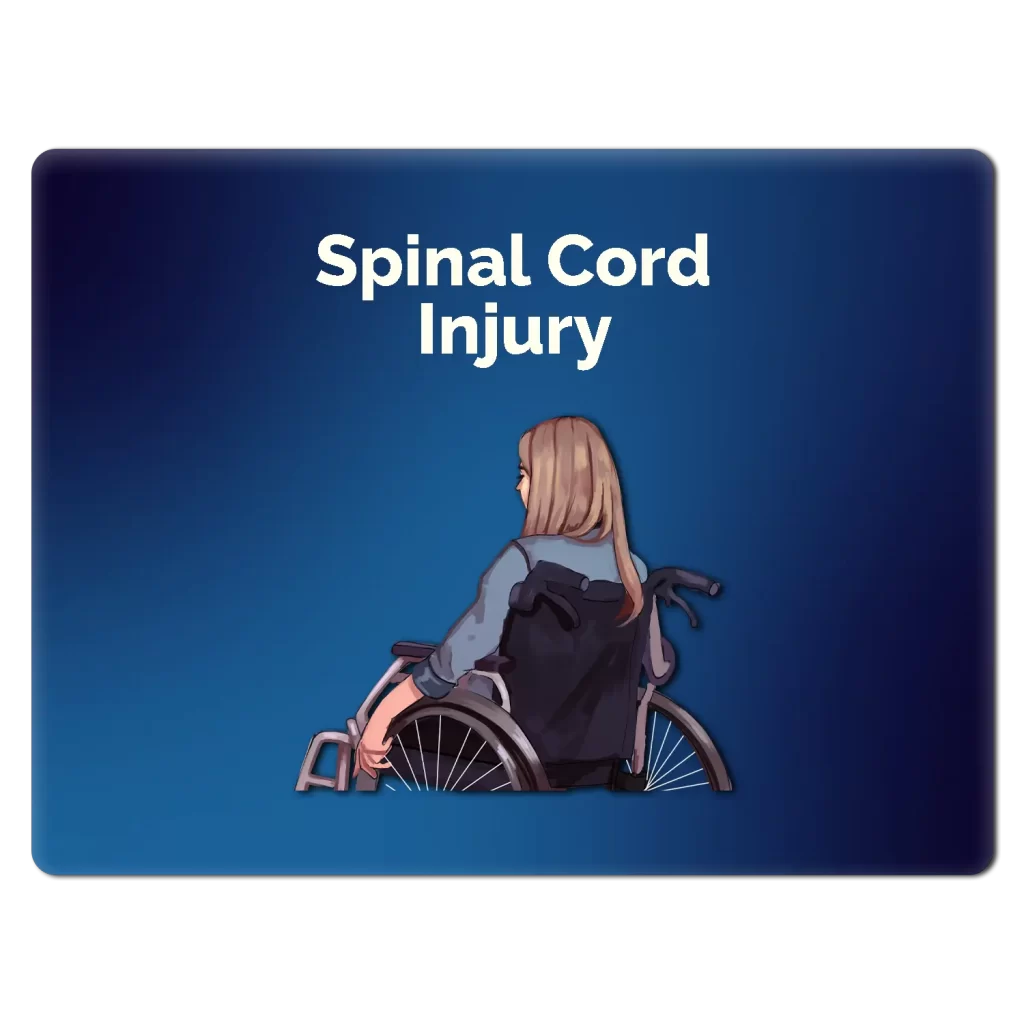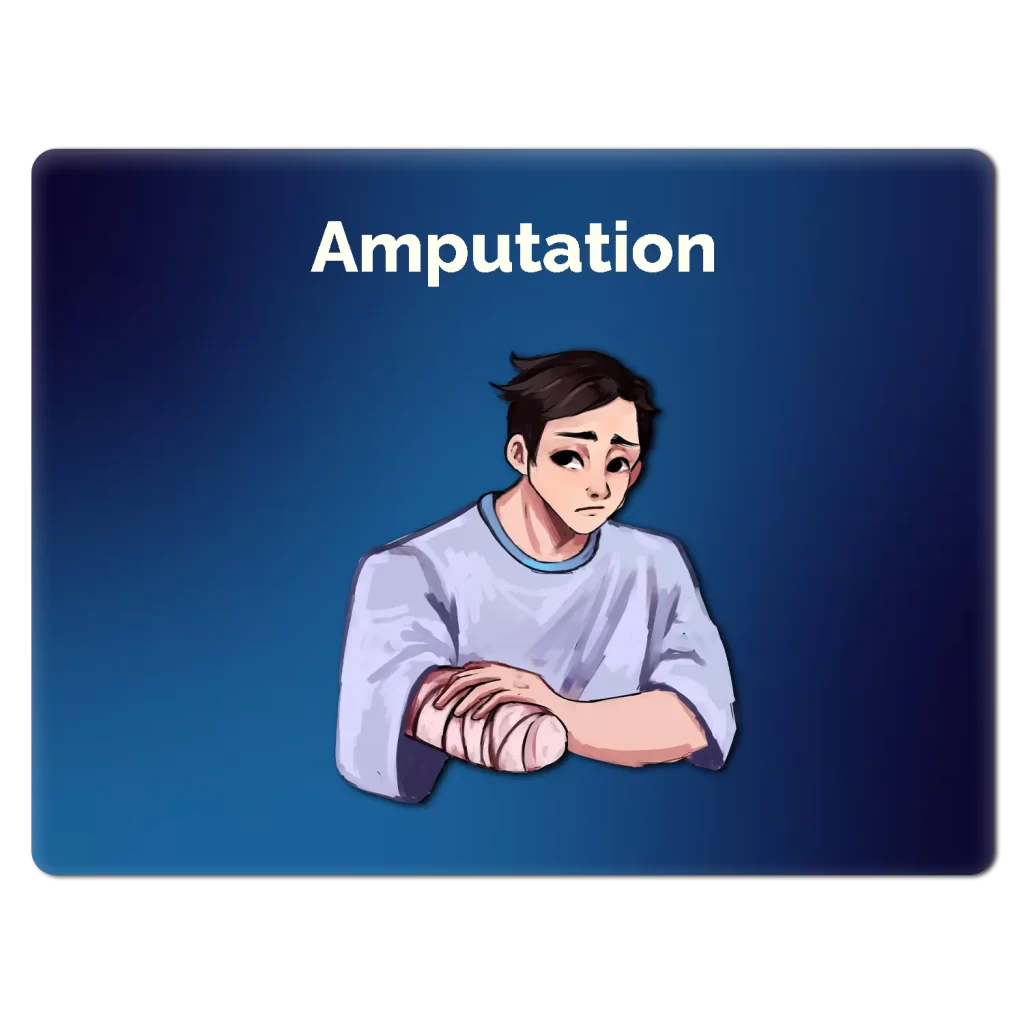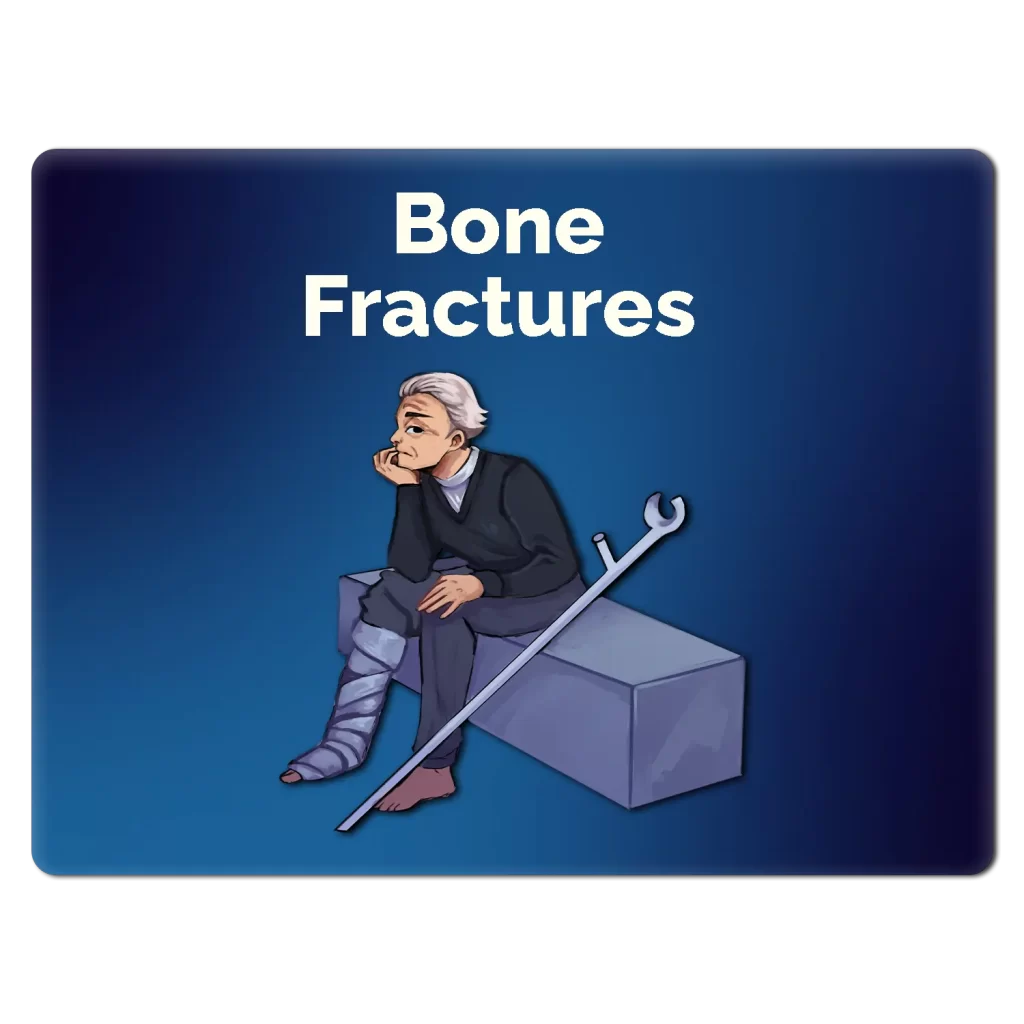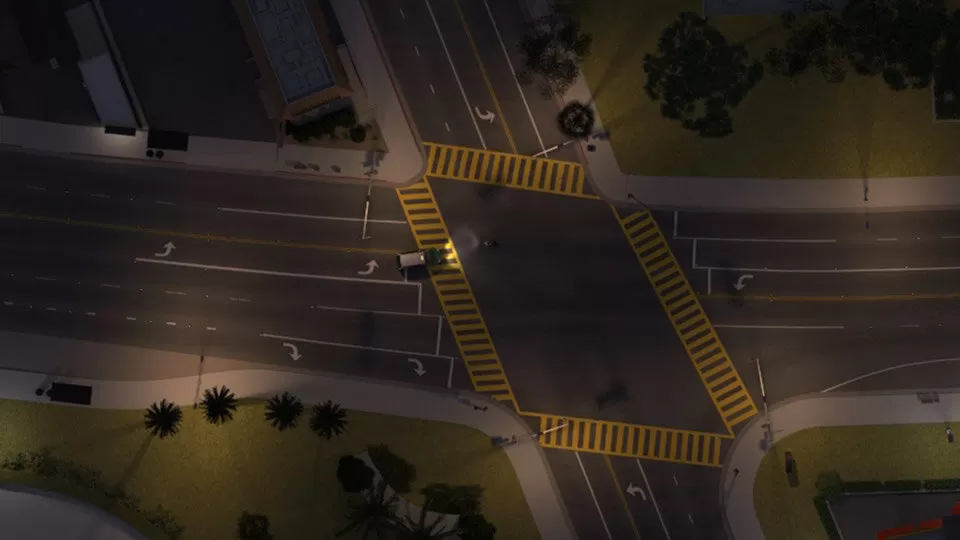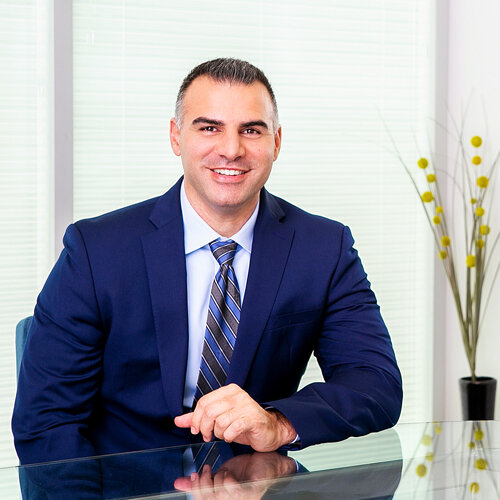Injured in a Motorcycle Accident? Our Firm Can Help
Mardirossian Akaragian LLP are strong defenders of the rights of California motorcycle riders. We have recovered over $40M for motorcyclists who have been seriously injured as a result of somebody else’s negligence or poor decision-making.
If securing legal counsel to protect your rights is necessary, our team of experienced motorcycle injury attorneys are ready to fight for you to recover the maximum compensation owed to you.
We offer a sound, team-oriented approach when handling personal injury cases involving motorcycle accidents. Not only can our attorneys aggressively advocate for you in settlement or trial, but they can also guide you through the entire process with compassion and empathy.
Talk to one of our Los Angeles motorcycle accident attorneys about your case or contact our firm to schedule a no-cost consultation.
Schedule Your Free Motorcycle Accident Case Evaluation
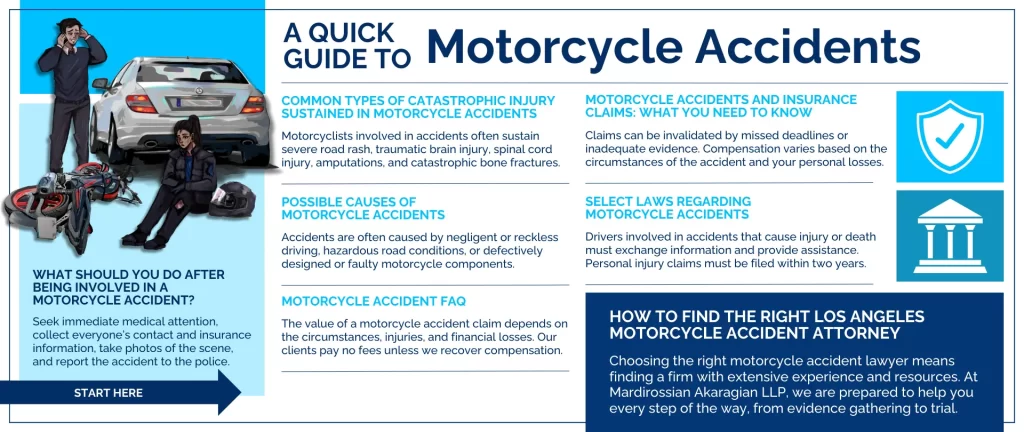
Motorcycle Accident Resources In This Article:
- What Should You Do After Being Involved in a Motorcycle Accident?
- Motorcycle Accident FAQ
- Common Types of Catastrophic Injury Sustained in Motorcycle Accidents
- Possible Causes of Motorcycle Accidents
- The Phases of a Motorcycle Accident Case
- Select Laws Regarding Motorcycle Accidents
- Motorcycle Accidents and Insurance Claims: What You Need to Know
- How To Find The Right Los Angeles Motorcycle Accident Attorney
- What Our Motorcycle Injury Clients Are Saying
What Should You Do After Being Involved in a Motorcycle Accident?
In the event of a motorcycle accident, some general steps to take include seeking medical attention, collecting everyone’s contact and insurance information, taking photos of the scene, and reporting the accident to the police
In this section:
- Seek Medical Attention If Necessary
- Gather As Much Information As You Can
- Call The Police
- Know Your Rights — Contact a Motorcycle Accident Lawyer
- What If I Was Involved in a Hit And Run?
The following is in no particular order:
Seek Medical Attention If Necessary
Assess yourself for injuries and seek medical attention if required. You may not feel as though you have suffered any harm, but some injuries can be difficult to detect. You may still be in shock which can make it difficult to tell if you are experiencing any pain. If in doubt, it is better to err on the side of caution and speak to a medical professional.
Gather As Much Information As You Can
If possible, get the contact information of everybody involved in the accident, especially names, current addresses and license plate numbers. Then, if you can, take photographs/videos of things that could be needed. Some suggestions of evidence to capture include:
- Any injuries sustained
- The extent of the damage to all vehicles involved in the collision
- Any issues with the roadway that are easily apparent
In addition, you may wish to take note of the following, especially if one or more of the drivers involved in the accident failed to stop or is refusing to cooperate:
- What you believe may have caused the incident
- The date and time the accident took place
- Where the accident took place. Be as specific as possible. Which road? Which part of that road? Which lane were you in?
- The weather conditions
- The names of any witnesses
Call The Police
California law mandates that the driver of any vehicle involved in an accident that results in either the injury or death of another person report the collision in writing to the police or CHP, if no law enforcement officer was present at the scene to make such a report at the time of the accident.
You, your insurance company, or your lawyer must also complete a Report of Traffic Accident Occurring in California (SR 1) with the DMV if there is more than $1000 in property damage, or if anyone was injured or killed.
A police incident report can be used to build a strong motorcycle accident lawsuit. Make sure to get a copy of this document as it may be required further down the line.
Know Your Rights — Contact a Motorcycle Accident Lawyer
It is generally recommended that people involved in a motorcycle accident seek legal advice. An experienced attorney can help you understand a multitude of critical factors concerning your accident, such as traffic laws, medical treatment, and perhaps most crucially, fault.
An attorney can also help you deal with insurance providers and look for all possible causes of the collision. Navigating an insurance claim can be a complicated process, and so it is highly recommended that you consult with an expert in motorcycle liability law to ensure that you position yourself for the best possible outcome.
Jump to this section for more information on how to find the best motorcycle injury lawyer for your circumstances.
What If I Was Involved in a Hit And Run?
Hit and run incidents are covered by two sections of the California Vehicle Code, Section 20001 and Section 20002:
Section 20001 states “The driver of a vehicle involved in an accident resulting in injury to a person, other than himself or herself, or in the death of a person shall immediately stop the vehicle at the scene of the accident.”
Violation of Section 20001 is a felony and carries a maximum jail time of four years and a maximum fine of $10,000, or both, depending on the severity of the injuries sustained as a result of the hit and run.
Section 20002 states “The driver of any vehicle involved in an accident resulting only in damage to any property, including vehicles, shall immediately stop the vehicle at the nearest location.”
Violation of Section 20002 is a misdemeanor and carries a maximum jail time of six months and a maximum fine of $1000, or both.
In the event of a hit and run, contacting the police can provide a good chance of finding the other driver.
There are numerous ways a reckless driver may be caught, and as stated in Assembly Bill 184. The statute of limitations for a hit and run offense gives a period of six years from the date of discovery for charges to be brought against the fleeing driver.
Improving Road Safety for Motorcyclists: Diamond & PCH, Redondo Beach
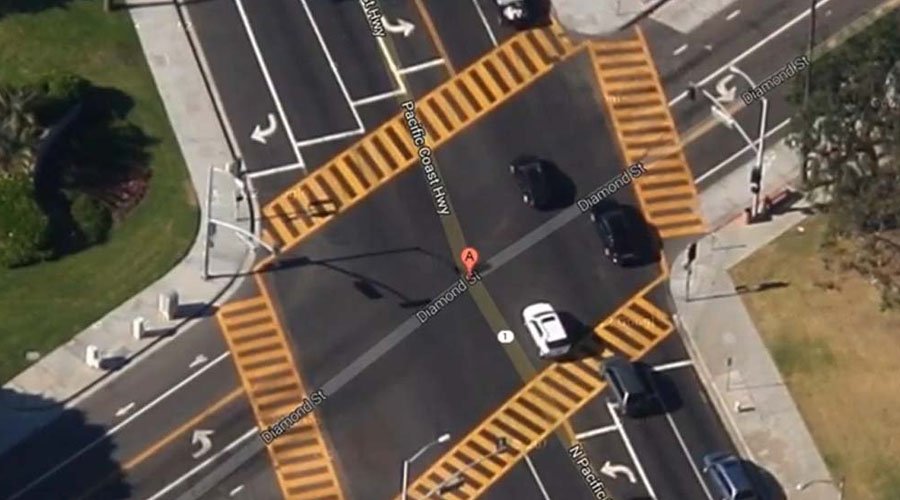
Ekbatani V. State Of California – $35,000,000.00
On July 14th, 2012, Amir Ekbatani was travelling along the Pacific Coast Highway when a taxi driver failed to yield at the Diamond St. intersection and collided with him.
Amir was thrown from his motorcycle, causing catastrophic injuries. Despite numerous surgeries, his leg had to be amputated below the knee.
We recovered a multi-million dollar award for Amir on the grounds that the California Dept of Transportation were fully aware of the dangers of the intersection, yet failed to implement the changes that would have made it safer. Since our victory at trial, CalTrans have implemented a double double yellow, a painted medium that prevents early left turns, significantly improving the safety of the intersection.
Motorcycle Accident FAQs
Q: How Much Is My Motorcycle Accident Claim Worth?
A: It depends on many factors, including how the collision occurred, why the collision occurred, the severity of your injuries, and your medical bills/lost earnings.
Q: Does Your Firm Specialize in Motorcycle Law?
A: Although lawyers in the personal injury field cannot be certified as a “specialist”, we have handled many motorcycle cases with significant success in the last 40 years.
Q: How Long Has Your Firm Been Practicing Law?
A: Our firm has been in business for over 40 years handling almost exclusively Plaintiff’s personal injury cases.
Q: What Happens If We Don’t Win?
A: No recovery means no fee.
Common Types of Catastrophic Injury Sustained in Motorcycle Accidents
Motorcyclists involved in accidents often sustain severe road rash, traumatic brain injury, spinal cord injury, amputations, and catastrophic bone fractures
In this section:
Motorcycle accidents involve some of the most devastating injuries and, tragically, often result in death. Injuries incurred by the motorcyclist in a motorcycle accident have a greater likelihood of being severe than they do for other vehicle users.
According to the Insurance Information Institute, motorcycle accidents are 26 times more likely to result in a fatality, while the National Highway Traffic Safety Administration (NHTSA) states that motorcycle riders are overrepresented in fatal traffic crashes. In 2019 alone, California was the state with the second highest number of motorcycle fatalities (474, with Florida having the most at 591).
The catastrophic injuries frequently incurred as a result of a motorcycle collision can have a profound impact on the injured person’s life. This can include considerations such as paying for extensive and expensive medical care, loss in household productivity, lost earning capacity, and significant emotional losses.
Here are some of the most severe types of injuries a rider may suffer as a result of being in a motorcycle accident:
Road Rash

Road rash is an abrasion wound in which the skin is scraped off through contact with another surface. Road rash wounds vary in their severity, and can include a combination of deep abrasions, avulsions, and lacerations. In severe instances, road rash may require a skin graft or a free flap procedure to limit scarring. Just like with regular burns, road rash injuries can be classified by degree. Road rash injuries can be fatal.
Types of Road Rash Wound
Abrasion Injury – open wound injuries caused by skin rubbing against a rough surface. Abrasion injuries can vary from mild (what you would typically call a scrape or graze) to severe.
Laceration Injury – cuts that go all the way through the skin. Deep lacerations go beneath the skin to underlying tissue layers and require urgent medical attention.
Avulsion Injury – traumatic injuries in which tissue is torn from the body, including all three layers of skin. If the avulsion wraps all the way around an extremity, this is referred to as degloving.
Factors Affecting the Severity of a Road Rash Injury
- The speed at which the motorcyclist was traveling
- The length of contact with the abrasive surface
- The type of road surface the skin comes into contact with
- Whether the rider was wearing gear
Motorcycle accidents that result in road rash can be incredibly costly to treat, especially in serious cases where hospitalization and surgery are required.
Traumatic Head/Brain Injury

Traumatic brain injury is any injury that causes disruption to the normal functioning of the brain. Motorcyclists are uniquely vulnerable to traumatic brain injuries especially considering their head is usually susceptible to direct trauma.
Spinal Cord Injury, Including Paralysis

A spinal cord injury is damage to the spinal cord that causes temporary or permanent disruptions below the site of injury. Spinal cord injuries are typically the result of trauma or disease, with auto and motorcycle accidents accounting for almost half of all new cases each year. It has been suggested that while head injuries are the leading cause of motorcycle deaths, spinal cord injuries are potentially more devastating to surviving individuals.
Amputation Injuries

Amputation is the loss or removal of a body part, either through trauma or surgery. Motorcyclists are particularly vulnerable to accidents that lead to amputation.
In many cases, it is the nature of the accident that leads to an amputation being required, rather than the accident itself. For instance, if a rider’s leg is pinned between the motorcycle and the ground preventing emergency services from rescuing them, or if an extremity is crushed beyond repair.
Bone Fractures

Depending on their severity, bone fractures can be catastrophic and in some cases, life-threatening. Large bones like the femur are tough to break, and so mostly occur in high intensity accidents like car accidents and motorcycle accidents.
A broken femur is incredibly painful and has a significant impact on an individual’s everyday life. Healing a broken femur almost always requires surgery, and typically takes between four to six months.
If you have suffered a broken femur due to being involved in a motorcycle accident, you have rights. You may be entitled to compensation for the pain and suffering you’ve experienced, the expensive medical treatment including surgery(s) and rehabilitation, and lost earning capacity during the time your broken femur is healing. Contact a Los Angeles motorcycle accident lawyer to discuss your accident.
Types of Femoral Fracture
There are several types of femoral fractures:
- Transverse fractures entail a break in a straight line across the femur
- Oblique fractures entail a break in an angled line across the femur
- Spiral fractures entail a break that encircles the femur in a striping fashion
- Comminuted fractures describe a femur that is broken in three or more places
- Open/compound fractures occur when the femur breaks through the skin
Complications Arising From a Broken Femur
Depending on the way in which the femur breaks and the severity of that break, a number of complications can arise. Some of these complications can be life-threatening, such as pneumonia, blood clots or infection.
Complications Arising Directly From the Femoral Fracture
- Bone fragments causing damage to surrounding tissue, for example tearing blood vessels or nerves
- Peripheral damage to ligaments, muscles and tendons as a result of the break
- Acute compartment syndrome, caused by muscle pressure reaching dangerous levels. Acute compartment syndrome is considered “one of the few true emergencies in orthopedics and traumatology.”
- Bone infection, which is difficult to treat, typically requiring multiple surgeries
Complications Arising From Surgery
- Infection
- Bleeding
- Improper setting, leading to one leg becoming shorter than the other
- Hip and knee pain
- Nerve injury
- Blood clots
- Hardware irritation, where metal implants irritate the surrounding tissue
- Fat embolism, where bone marrow enters the bloodstream
Serious bone fractures require lengthy healing periods which often require numerous surgeries and physical therapy to ensure the fracture properly heals, all of which is very expensive.
–
If you are worried about being able to pay for the treatment for your or your loved one’s injury in the aftermath of a catastrophic accident, you should speak to an expert motorcycle accident lawyer who can get you the maximum compensation you may be owed.
Possible Causes of Motorcycle Accidents
Motorcycle accidents are often caused by negligent or reckless driving, hazardous road conditions, or defectively designed/faulty motorcycle components
In this section:
Because motorcyclists are often more difficult to see than cars and trucks, they are uniquely vulnerable on the road. However, this does not excuse a driver who causes a crash because he or she was not paying attention or watching out for motorcyclists.
Some of the factors that contribute to motorcycle accidents include the following:
1. Negligent/Poor Driving
When a motorcycle is involved in a crash with another vehicle, the cause of the crash is often attributable to the driver of the vehicle because he or she failed to see the motorcycle and impeded the motorcyclist’s right-of-way. An example of such a crash is the Lewis v. Ukran case, covered below.
Motorcyclists are smaller visual targets, so drivers have to always pay attention when making maneuvers on the public roads. Those maneuvers include:
- Entering or exiting intersections, as in the case of Ekbatani v. State of California, outlined above
- Changing lanes
- Making left and right turns
- Moving in and out of driveways
The risk to a motorcyclist is significantly increased when drivers make poor decisions and chose to drive:
Under the Influence (DUI)
Sadly, over 9000 Californians lost their lives in alcohol-impaired crashes between 2009 and 2018. Statistically, one American dies every hour in an alcohol-related crash.
Drowsy
At least 795 Americans lost their lives in 2017 due to crashes caused by drowsy driving. The Governors Highway Safety Administration (GHSA) estimates that between 10 and 20 percent of large truck and bus crashes are caused by tired or exhausted drivers.
Distracted
Using a handheld device while driving significantly increases the risk of a crash. Other distractions which increase the risk of a crash include eating, applying makeup, or engaging in stressful conversations with passengers.
Aggressively
Sometimes known as “road rage,” aggressive driving includes cutting off or tail-gating other drivers, honking or gesturing for unnecessary reasons, or intentionally preventing another driver from passing.
Too Fast
According to the National Highway Traffic Safety Administration (NHTSA), speeding was a contributing factor in almost a third of all traffic fatalities in 2020.
2. Dangerous Roadways
California’s roads have been known to be dangerous. Particularly deadly stretches of roadway include the I-15 in Hesperia, I-80 in Oakland/Berkeley, and the I-5 in Sacramento from Del Paso Road to Railyards Boulevard.
California is also second in the nation for rural road fatalities. Some surveys find that up to one in five solo motorcycle crashes are caused by defects in the roadway, including potholes.
3. Defectively Designed/Faulty Vehicles or Parts
Since the adoption of the National Traffic and Motor Vehicle Safety Act of 1966,the NHTSA has issued minimum standards for vehicles. As part of its administrative duties, NHTSA, on occasion, has recommended manufacturers to voluntarily recall vehicles. Such NHTSA recommendations have resulted in more than 390 million recalled vehicles.
However, not all recall campaigns by manufacturers raise enough public awareness. California has the most vehicles “with unrepaired safety recalls” in the nation – an estimated 5.6 million of them as of mid-2022.
Recent motorcycle recalls include the following:
- Harley-Davidson recalled roughly 175,000 motorcycles in 2018 due to a concern about brake failure.
- Honda recalled some 2021 model year off-road motorcycles (CRF450R) for a defective drive chain.
Often riders are not aware of these defects (and cannot be expected to be), which is why it is crucial that manufacturers and distributors take action when defects that warrant a recall are brought to their attention.
What Happens During a Recall?
A recall requires the manufacturer to perform several acts:
- First, the manufacturer must file a public report detailing the defect, the vehicle involved, the events which determined that a recall was necessary, a proposed remedy, and a schedule for the recall to occur.
- Next, the manufacturer must attempt to notify the owners of the problem.
- Finally, the manufacturer must fix the defect at no cost to the owner. (Recall information and updates can be found on the NHTSA’s website).
We are meticulous when it comes to evaluating and investigating any details in a motorcycle accident case. We work tirelessly to determine who was at fault for the accident and strive to hold the liable parties responsible.
–
No matter how complex your case may be, we will work to obtain fair and just compensation for your harms and losses, including medical bills, lost wages, pain and suffering, and more. If you have lost a loved one in a fatal motorcycle accident, we can explain your legal options and help you pursue a wrongful death claim.
Bringing Justice to Motorcyclists Against Negligent Drivers
Lewis v. Ukran – $2,650,000.00
On March 26, 2013. Thyme Lewis was riding his motorcycle when a van made a left turn in front of him. Despite braking, the front wheel of Thyme’s motorcycle hit the side of the van, and he was thrown from his motorcycle. He landed on the roof of the van, sustaining serious injuries which consequently ended his career as a stuntman.
In 2018, we obtained a verdict for $1,654,000.00 after the defendant in the case only offered $150,000.00. Eventually, the defendant paid more than $2,650,000.00 after adding interest and costs to the verdict.
In 2019, the California Court of Appeal published the case.
The Phases of a Motorcycle Accident Case
Motorcycle accident cases typically involve engaging with insurance companies, sending information to insurance companies, filing a lawsuit, navigating discovery and, if it comes to it, proceeding to trial
In this section:
- Engaging with Insurance Companies
- Sending the Necessary Information
- Filing the Lawsuit
- Navigating Discovery
- Proceeding to Trial
With an experienced motorcycle accident attorney already on your side, you will be better prepared to navigate the complexities of a motorcycle accident claim, from the initial contact with insurance companies to potential court proceedings.
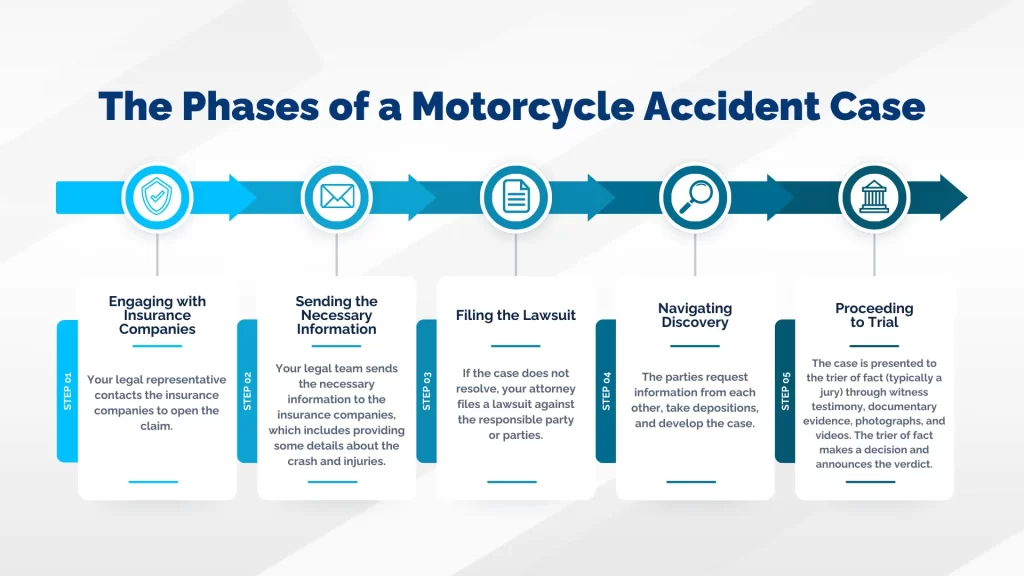
1. Engaging with Insurance Companies
One of the first things you will need to do after being in a motorcycle accident is to talk to the insurance companies involved to discuss possible compensation for your injuries and damages. Your lawyer will help you present your case, emphasizing the extent of your injuries and the impact on your life. This step establishes the parameters for a potential settlement and can sometimes lead to a favorable resolution without the need for further legal action.
2. Drafting the Demand Letter
At this stage of the process, your lawyer will sometimes send a demand letter to the at-fault party’s insurance company. This document outlines the details of the collision, the nature of your injuries, the treatment you received, and any financial consequences of the incident, including medical expenses and lost wages. If the demand fails to produce a settlement, it may follow with a lawsuit.
3. Filing the Lawsuit
At this juncture, your lawyer will prepare and submit a lawsuit on your behalf to the court. This typically marks the shift from the pre-litigation stage to the formal litigation process. The documents then have to be served on the defendant(s), usually by a process server or Sheriff’s Deputy. After service, the defendant has a specific amount of time to respond or file an answer.
4. Navigating the Discovery Phase
Once the lawsuit is filed, the discovery phase begins. During this phase, the parties exchange information, when demanded, including written discovery (interrogatories and requests for admission), document production, and depositions. One of the objectives is to try to collect all relevant information. If a settlement is still not reached after discovery, the case will proceed to trial.
5. Proceeding to Trial
If the case proceeds to trial, there will be several key stages, including jury selection, opening statements, presentation of evidence, witness testimony, and closing arguments. After the case is presented, the trial concludes with the jury or judge reaching a verdict.
Select Laws Regarding Motorcycle Accidents
Drivers involved in accidents that cause injury or death must exchange information and provide assistance. Personal injury claims must be filed within two years
In this section:
- Obligations of a Driver Who Injures a Motorcyclist
- How Long Do I Have to File a Motorcycle Accident Claim?
Obligations of a Driver Who Injures a Motorcyclist
According to the California Vehicle Code § 20003:
The driver of any vehicle involved in an accident resulting in injury to or death of any person shall give his or her name, current residence address, the names and current residence addresses of any occupant of the driver’s vehicle injured in the accident, the registration number of the vehicle he or she is driving, and the name and current residence address of the owner to the person struck or the driver or occupants of any vehicle collided with, and shall give the information to any traffic or police officer at the scene of the accident.
The driver also shall render to any person injured in the accident reasonable assistance, including transporting, or making arrangements for transporting, any injured person to a physician, surgeon, or hospital for medical or surgical treatment if it is apparent that treatment is necessary or if that transportation is requested by any injured person.
Additionally, any driver or injured occupant of a driver’s vehicle shall also, upon being requested, exhibit his or her driver’s license, if available, or, in the case of an injured occupant, any other available identification, to the person struck or to the driver or occupants of any vehicle collided with, and to any traffic or police officer at the scene of the accident.
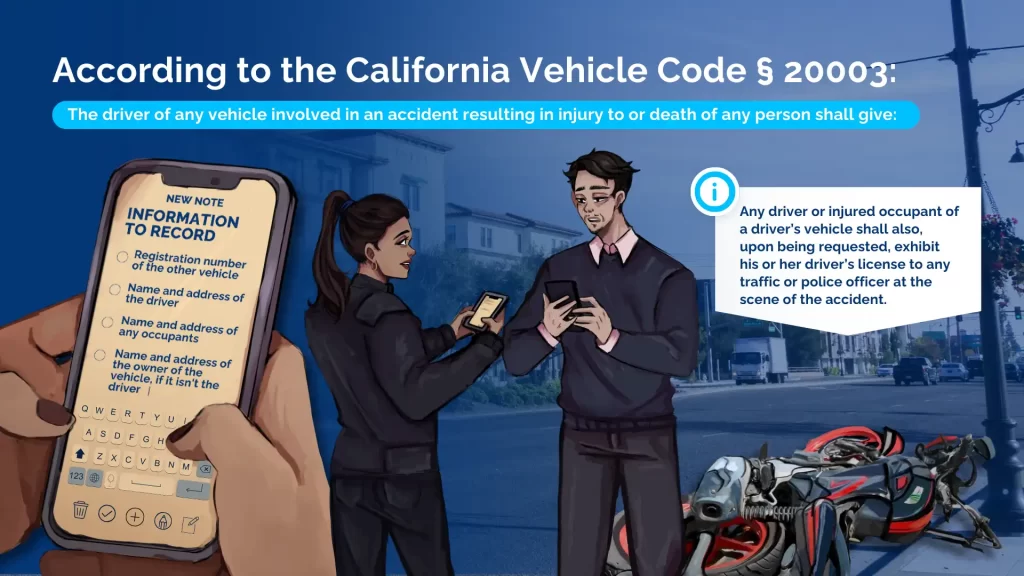
How Long Do I Have to File a Motorcycle Accident Claim?
Under California’s Statute of Limitations (Civ. Proc. §335.1), you have two years from the date of the accident to file a personal injury lawsuit. If you are considering filing a lawsuit due to injuries suffered in a motorcycle accident, you should consult an experienced motorcycle accident attorney today.
Our Motorcycle Accident Victories
Motorcycle Accidents and Insurance Claims: What You Need to Know
Motorcycle accident claims can be invalidated by missed deadlines or inadequate evidence. Compensation varies based on the circumstances of the accident and your personal losses
In this section:
If you have concerns about navigating an insurance claim when it comes to your motorcycle accident, you should consider hiring an experienced motorcycle injury attorney who can guide you through the process.
Mardirossian Akaragian LLP offers abundant resources, a proven track record of winning, and a powerhouse legal team to provide you with the best chance of winning the maximum compensation owed to you.
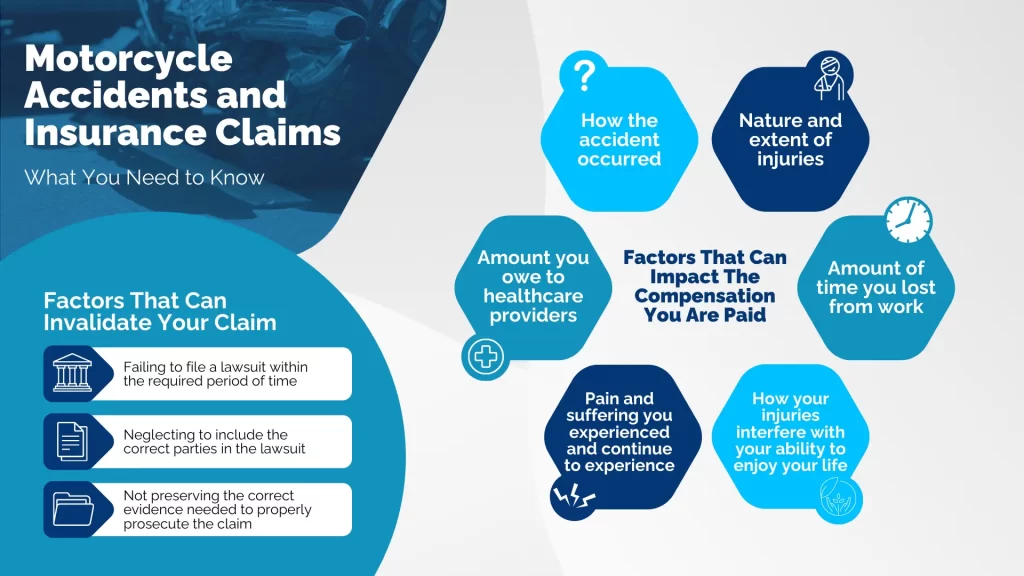
Factors That Can Invalidate Your Claim
Many factors can invalidate your claim, including failing to file a lawsuit within the required period of time, neglecting to include the correct parties in the lawsuit, and not preserving the correct evidence needed to properly prosecute the claim.
Factors That Can Impact The Compensation You Are Paid
Factors which can affect your compensation include:
- How the accident occurred
- The nature and extent of your injuries
- The amount of time you lost from work
- The amount you owe to healthcare providers
- The pain and suffering you experienced and continue to experience
- How your injuries interfere with your ability to enjoy your life
How To Find The Right Los Angeles Motorcycle Accident Attorney
Navigating a motorcycle accident case can be difficult with experienced legal counsel. It is imperative you choose a firm with extensive experience and resources
While there is no doubt that there are many fine law firms throughout LA County, it is a simple fact that only certain firms are able to go the distance. Sadly it is often the case that a firm with the law on their side loses because the opposition is able to beat them through sheer resource.
Mardirossian Akaragian LLP is a powerhouse law firm with the necessary resources needed to go the distance. With a track record of major case victories and a combined total of over half a billion dollars secured for our injury clients, your motorcycle injury claim is in the right hands with us.
Ways Our Firm Can Help With Your Motorcycle Accident Claim
We can conduct a thorough investigation of the circumstances surrounding your accident, helping you to build a solid case by:
- Gathering evidence, such as witness statements, police reports and medical documents
- Working with accident reconstructionists, engineers, medical professionals, forensic economists and other qualified experts
- Reconstructing the crash through our signature use of virtual and physical 3D models
- Communicating with insurance companies
- Taking your case to trial if necessary
Contact one of our experienced motorcycle accident lawyers today to schedule a no-cost consultation.
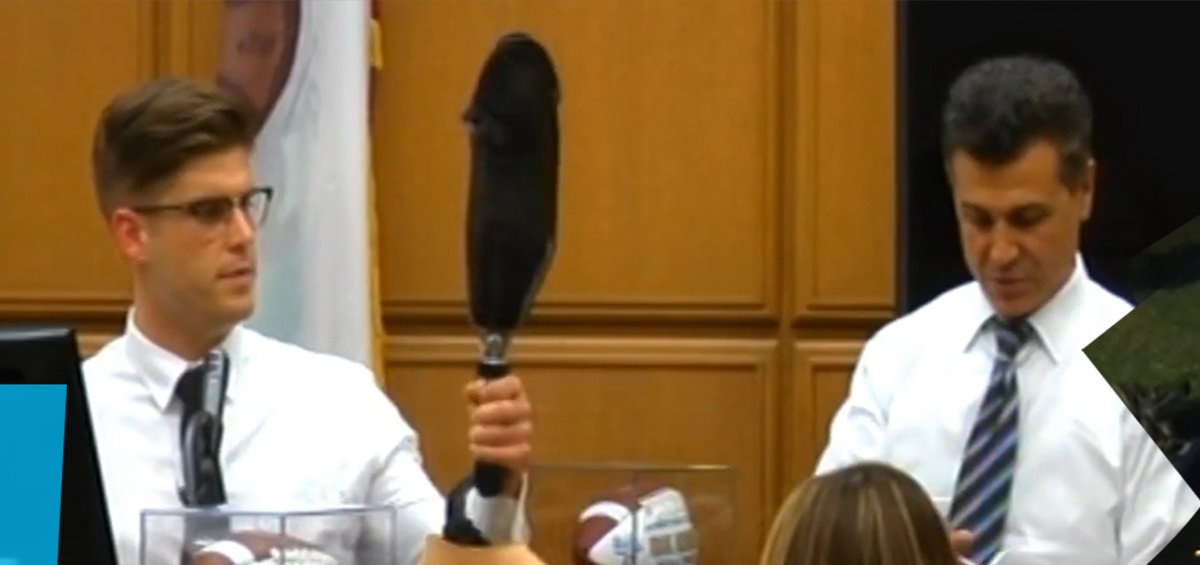
Amir Ekbatani & Garo Mardirossian during a motorcycle accident trial where Amir was awarded $35M for his injuries.
What Our Motorcycle Injury Clients Are Saying
I had really hard times after my accident.
It wasn’t the proudest time of my life. I had to lean on family, I had to lean on Garo. He supported me with my medical bills. He gave me a place to live. He just had my back.
I felt like I was on a team again. I felt supported. There were ups and downs but I always felt like Garo had my back, and that I really couldn’t go wrong.
No matter happened, I knew that I could trust Garo.
— Amir Ekbatani
Let Our Firm Fight for Your Rights and Your Future
We offer a sound, team-oriented approach when handling personal injury cases involving motorcycle accidents. Not only can our attorneys aggressively advocate for you in settlement or trial, but they can also guide you through the entire process with compassion and empathy. We understand the difficult situation you are in and it’s our goal to help you recover the fair compensation you are owed.
With more than 40 years of combined experience, our Los Angeles motorcycle accident attorneys are focused on recovering the maximum compensation on your behalf, whether through settlement or at trial. We understand that motorcycle accidents can cause immeasurable damage. We handle every aspect of your claim from start to finish so you can focus on getting the treatment you need.
Our firm offers exceptional talent, abundant resources, tireless dedication, and years of experience to give you the best chance of success in obtaining maximum compensation. Led by our award-winning attorneys, Garo Mardirossian and Armen Akaragian, we are prepared to provide you with aggressive representation and personalized legal guidance you need.
Talk to a Los Angeles motorcycle injury lawyer about your case or contact our firm to schedule a no-cost consultation.
Schedule Your Free Motorcycle Accident Case Evaluation
Article By
ARMEN AKARAGIAN
Admitted to practice in 2006, Armen has arbitrated, tried, and settled several cases which have resulted in multi-million dollar verdicts and settlements.
Sources cited in this article:
- CHAPTER 1. Accidents and Accident Reports [20000 – 20018] – California Legislative Information
- Vehicle Collisions – State of California Department of Motor Vehicles
- Report of Traffic Accident Occurring in California (SR 1) – State of California Department of Motor Vehicles
- Motorcycle Accident FAQ – FindLaw
- CHAPTER 1. Accidents and Accident Reports [20001] – California Legislative Information
- CHAPTER 1. Accidents and Accident Reports [20002] – California Legislative Information
- What to do after a hit and run in California – Bankrate
- AB-184 Statute of limitations. – California Legislative Information
- Non-fatal spine injuries resulting from motorcycle crashes – ScienceDirect
- Background on: Motorcycle crashes – Insurance Information Institute
- Motorcycle Safety – NHTSA
- Fatality Facts 2019, State by State – Insurance Institute for Highway Safety
- What to Know About Road Rash – WebMD
- Hit the road, jacked—road rash injuries – Bulletin of the American College of Surgeons
- Plastic Surgery for Burns and Other Wounds – WebMD
- Everything You Should Know About Skin Abrasions – Healthline
- Wound Home Skills Kit: Lacerations & Abrasions – American College of Surgeons Division of Education
- How To Treat an Avulsion or Degloving – Verywell Health
- Traumatic Brain Injury – American Association of Neurological Surgeons
- Spinal Rehabilitation Center: Injury and Paralysis Information – Shepherd Center
- Spinal Cord Injury Information Page – National Institute of Neurological Disorders and Stroke
- Spinal cord injury – World Health Organization
- Spinal cord injury – Mayo Clinic
- Non-fatal spine injuries resulting from motorcycle crashes – ScienceDirect
- Spinal Cord Injury – American Association of Neurological Surgeons
- Acute Spinal Cord Injury – Hopkins Medicine
- Cervical Spinal Cord Injury: Symptoms and Prognosis – Shepherd Center
- Thoracic Spinal Cord Injuries: Symptoms and Recovery – Shepherd Center
- Lumbar Spinal Cord Injury Overview – Shepherd Center
- Paralysis – Healthline
- Amputation – Hopkins Medicine
- Practical coping strategies to help amputees and their families – Limbs4Life
- Emotional and Psychological Reactions to Amputation – Physiopedia
- Motorcycle Accident Amputation Injuries – Motorcycle Legal Foundation
- Traumatic Amputations – EMS World
- Complications Post Amputation – Physiopedia
- Residual limb pain – Mayo Clinic
- Phantom pain – Mayo Clinic
- Femur Fracture – Orthopedic Medical Center
- Broken Femur – Healthline
- Femur Shaft Fractures (Broken Thighbone) – OrthoInfo
- Femur Fracture Open Reduction and Internal Fixation – Hopkins Medicine
- Physical Therapy Guide to Femur Fracture – ChoosePT
- Compartment syndrome – Cleveland Clinic
- Acute compartment syndrome – Muscle, Ligaments and Tendons Journal
- Femur Fracture – Orthopedic Medical Center
- National Agenda for Motorcycle Safety – NHTSA
- Motorcycle Accidents: Overview – FindLaw
- 4 Summer Driving Hazards to Be Aware Of – Travelers Insurance
- Sobering Facts: Alcohol-impaired Driving California – Centers for Disease Control and Prevention
- DUI Crackdown – California Office of Traffic Safety
- Drowsy Driving – California Office of Traffic Safety
- Distracted Driving – California Office of Traffic Safety
- California Traffic Violations – StateRecords
- The Deadliest Roads in California – MoneyGeek
- Report: California’s Rural Roads In Disrepair And Deadly – CBS Bay Area
- A fatal flaw in our roads: MCN Compare survey reveals true extent of pothole menace – Motorcycle News
- 718 public law 89.563-sept. 9, 1966 – GovInfo
- Motor Vehicle Safety Defects and Recalls – NHTSA
- California Has the Most Vehicles with Unfixed Safety Recalls – Automotive Fleet
- Harley-Davidson recalls 175K motorcycles nationwide – VisaliaTimesDelta
- Off-Road Motorcycles Recalled by American Honda Due to Crash and Injury Hazards (Recall Alert) – US Consumer Product Safety Commission
- Motorcycle Defects and Recalls – FindLaw
- Thyme Lewis – Biography – IMDb
- Cal. Veh. Code § 20003 – Casetext
- Statute of Limitations – California Courts
- TITLE 2. OF THE TIME OF COMMENCING CIVIL ACTIONS [312 – 366.3] – California Legislative Information
